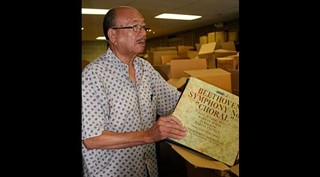Remer Pendergraph stands in a room amongst piles and piles of boxes.
Inside the boxes are the many books, albums, paintings, magazines, letters and other artifacts relating to Savannah African–American life collected by his friend W.W. Law, the beloved community activist and historian who Dr. Martin Luther King, Jr. called “the most important civil rights figure in the South.”
When Mr. Law passed away in 2002, he entrusted the massive collection to Mr. Pendergraph, who has been overseeing the preservation of what is quite possibly the largest collection of African–American history in the Southeast (over 100,000 items)ever since.
“This is no ordinary work,” declares the director of the W.W. Law Foundation. “I knew he was going to will everything to me when he died, but I didn’t know I’d be in over my head.”
While the material has been organized into this tower of boxes, only twenty–five percent of the items have been catalogued by professional archivists, funded by a special sales tax in 2003–2008. The aim of the foundation is to see the whole lot categorized and available for public viewing in its own research library, to be housed in the city’s soon–to–be–built cultural arts center.
Ten years after Law’s death, however, the foundation struggles not only to keep itself financially afloat, but also to remain relevant in the minds of today’s Savannahians. Though there was a time when “anybody who knew anybody who knew anything about Savannah knew about Mr. Law,” many who have moved the city in the last decade know nothing of him. Even if his name sounds familiar, the scope and significance of his work remains hidden.
Enter Ben Brown, a SCAD graphic design graduate student from Tacoma, Washington. Brown came to Pendergraph earlier this year with a proposal: Bring more awareness to the W.W. Law Foundation using large banners on buildings and buses that bear an image of Law’s smiling face and a quote:
“I was the result of a composite contribution. I tried not to have a big ending, but rather, to live my life doing the best I could each day, because a good name is rather to be chosen than great riches.”
These thoughtful words, inscribed on Law’s headstone, struck Brown deeply when he came across them during research for a class. Inspired by Law’s commitment to the idea of Dr. King’s all–inclusive Beloved Community, he conceived the project to help Pendergraph keep Law’s visionary work visible.
“Savannah is a city that tells its history visually, and I noticed there was a real lack of visual narrative for the African–American community,” recalls Brown.
“Mr. Law is someone I can believe in,” he continues. “I met him through his words, and I thought that’s the way the city can meet him, too.”
At first, Pendergraph was surprised at such enthusiasm from a newcomer to Savannah.
“He came out of the blue sky,” he laughs. “But he’s done everything he said he would do.”
Together the two men—one older and black, the other young and white—have created a three–month long campaign that has unfurled banners on Savannah’s institutions dedicated to African–American history, behind every one of which Law was a rallying figure in its establishment: The King Tisdale Cottage, an homage to coastal African–American heritage; The Beach Institute, showcasing art by sculptor Ulysses Davis; and the Ralph Mark Gilbert Civil Rights Museum, chronicling the local marches and non–violent protests of which Law was an integral part.
The mural campaign is mobile, too, befitting Law’s lifelong commitment to public transportation: Several CAT buses display the murals, piquing the interest of drivers and passersby all over the city.
Law spent 40 years as a mail carrier, and included in this awareness effort is a special cancellation stamp created by the United States Post Office. While Law hasn’t been commemorated with his own postage stamp yet, the city’s Fahm Street Post Office location approved a way to honor its former colleague in a proper way.
“This is what we use to cancel letters and show the date,” explains Amy Wing, secretary to the Postmaster General. “People can come down here and get their bills and birthday cards hand–stamped and send them on their way, or they can keep them as a souvenir.”
Wing says philatelists from all over the country are sending her self–addressed stamped envelopes to cancel with the W.W. Law stamp so they can add the commemorative graphic to their collections. The special cancellation stamp will be available at the Fahm Street station through October.
Back at the headquarters of the W.W. Law Foundation, Pendergraph sifts through original documents from early meetings of the NAACP, a letter from President John F. Kennedy reinstating Law to his job at the post office after he was fired for protesting segregation, a first-issue 1960s Ebony magazine bearing a cover portrait of Lena Horne. Along the walls are more than 7000 books, old maps, paintings by African–American artists and framed photographs of anonymous relatives.
Pendergraph and Brown hope the increased awareness from the public art campaign will translate into more funding and a few grant–savvy volunteers. They estimate that it will take two years to render this this mountain of materials into a collection that will fill the future W.W. Law Research and Preservation Center.
“He cracked the foundation of his house with all of it,” remembers Pendergraph, who spent an entire year moving and sorting along with a team of others committed to the cause.
Those who knew Law understood that how adamant he was that every shred of the African–American experience was valuable.
“Everybody’s story mattered to him,” remembers his old friend.
Adds Brown: “He was trying to hang on to the community in any way he could.”




























